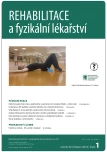-
Medical journals
- Career
The effect of physiotherapy on the quality of motion patterns in impingement syndrome
Authors: Blaščáková S. 1; Musilová E. 2; Žiaková E. 1; Sládeková N. 3
Authors‘ workplace: Fakulta ošetrovateľstva a zdravotníckych odborných štúdií, Slovenská zdravotnícka univerzita v Bratislave, Slovenská republika 1; Fakulta telesnej výchovy a športu, Univerzita Komenského v Bratislave, Slovenská republika 2; Fakulta zdravotníckych vied, Univerzita sv. Cyrila a Metoda v Trnave, Piešťany, Slovenská republika 3
Published in: Rehabil. fyz. Lék., 30, 2023, No. 1, pp. 34-39.
Category: Original Papers
doi: https://doi.org/10.48095/ccrhfl202334Overview
The upper extremity is an important and complicated organ that enables a wide range of movements necessary for work, creation and realization of intentions. Problems in the area of the shoulder joint have a significant impact on a person’s quality of life. The shoulder, as the root joint of the upper limb, is the most mobile and, at the same time, the most anatomically and functionally complex joint of the body. Due to its specific structure, a large range of movement and constant activity, it is easily vulnerable and impingement syndrome can occur. It occurs in an increasingly younger population of productive age and is the cause of long-term incapacity for work. However, with targeted physiotherapy, it is possible to influence functional changes and pathological muscle concatenation in the given area, which qualitatively improves the movement stereotype. We investigated 20 patients with a diagnosis of impingement syndrome without a previous surgical solution. With targeted physiotherapy, we were able to largely successfully eliminate pain in 85% of patients, normalize the increased tone of the upper fixators and timing in 60% of patients, and correctly fix the scapula in 70% of patients.
Keywords:
Physiotherapy – impingement syndrome – shoulder abduction stereotype – arm-support stereotype – stabilization of the scapula
Sources
1. Lagatorová S, Levitová A, Daďová K et al. Zranění horních končetin u hráčů golfu. Rehabil Fyz Lék 2020; 27(4): 218–224.
2. Valouchová P, Kolář P. Kineziologie pletence ramenního. In: Kolář P (ed). Rehabilitace v klinické praxi. Praha: Galén 2009. ISBN 978-80-7262-657-1.
3. Bross J, Fetto J, Rosen E. Vyšetření pohybového aparátu. 2. vyd. Praha: Triton 2005.
4. Mayer M, Smékal D. Syndromy bolestivého a dysfunkčního ramene: role krátkych depresoru hlavice humeru. Rehabil Fyz Lék 2005; 12(2): 68–71.
5. Kolář P (ed). Rehabililace v klinické praxi. Praha: Galén 2020.
6. Rychlíková E. Funkční poruchy kloubů končetin. Diagnostika a léčba. 2. dopl. vyd. Praha: Grada Publishing 2002.
7. Vyskotová J, Macháčková K. Jemná motorika. Vývoj, motorická kontrola, hodnocení a testování. Praha: Grada Publishing 2013.
8. Wyss J, Patel A. Therapeutic programs for musculoskeletal disorders. 1st ed. New York: Demos Medical Publishing 2013.
9. Lisý M, Méryová D. Syndróm bolestivého pleca – možnosti terapie. Rehabilitácia 2004; 41(3): 159–165.
10. Ditmar D. Moderní artroskopická operativa ramenního kloubu – vlastní klinické zkušenosti. Rehabil Fyz Lék 2004; 1 : 19–24.
11. Michalíček P, Vacek J. Rameno v kostce. I. část. Rehabil Fyz Lék 2014; 21(3): 151–162.
12. Lewit K. Manipulační léčba. Praha: Sdělovací technika 2003.
13. Donatelli R (ed). Physical therapy of the shoulder. 5th ed. Elsevier/Churchill Livingstone 2012.
14. Neer CS 2nd. Anterior acromioplasty for the chronic impingement syndrome in the shoulder. 1972. J Bone Joint Surg Am 2005; 87(6): 1399. doi: 10.2106/JBJS.8706.cl.
Labels
Physiotherapist, university degree Rehabilitation Sports medicine
Article was published inRehabilitation & Physical Medicine

2023 Issue 1-
All articles in this issue
- Hand function and handwriting treatment program in post-stroke patients – a pilot study
- Physiotherapy in primary and lower-secondary school children with poor posture
- Relationship between diastasis recti abdominis and back pain in postpartum women
- Analysis of the preferred writing tool grip in Czech university students
- The effect of physiotherapy on the quality of motion patterns in impingement syndrome
- Development of rehabilitation in the Czech Republic
- The Franklin Method – body and movement in imagination
- Rehabilitation & Physical Medicine
- Journal archive
- Current issue
- Online only
- About the journal
Most read in this issue- Development of rehabilitation in the Czech Republic
- Physiotherapy in primary and lower-secondary school children with poor posture
- The Franklin Method – body and movement in imagination
- The effect of physiotherapy on the quality of motion patterns in impingement syndrome
Login#ADS_BOTTOM_SCRIPTS#Forgotten passwordEnter the email address that you registered with. We will send you instructions on how to set a new password.
- Career

